| Listing 1 - 10 of 19 | << page >> |
Sort by
|
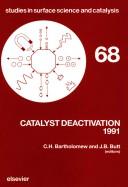
ISBN: 0444888322 9786611789404 1281789402 008088699X 9780444888327 9780080886992 9781281789402 6611789405 Year: 1991 Publisher: Amsterdam New York Elsevier
Abstract | Keywords | Export | Availability | Bookmark
 Loading...
Loading...Choose an application
- Reference Manager
- EndNote
- RefWorks (Direct export to RefWorks)
Catalyst Deactivation 1991 was an expanded version of earlier, highly successful symposia. The symposium featured invited and solicited papers including 4 plenary lectures, 78 oral presentations and 23 poster papers. Most of the papers are contained in this volume. The eight main topics emphasised at this most recent symposium were: deactivation mechanisms/phenomena (carbon deposition, poisoning, and sintering), methods (modeling and techniques), and important catalysts (hydrotreating, oxides, and zeolites). All of these areas were well represented as attested by the substantial num
Conferences - Meetings --- Catalyst poisoning --- Catalysis --- Catalyst deactivation --- Catalysts --- Catalytic poisoning --- Poisoning of catalysts --- Deactivation

ISBN: 0444502130 9780444502131 Year: 1999 Publisher: [Place of publication not identified] Elsevier Science Imprint
Abstract | Keywords | Export | Availability | Bookmark
 Loading...
Loading...Choose an application
- Reference Manager
- EndNote
- RefWorks (Direct export to RefWorks)
Catalyst poisoning --- Catalyst poisoning. --- Catalyst deactivation --- Catalysts --- Catalytic poisoning --- Poisoning of catalysts --- Deactivation
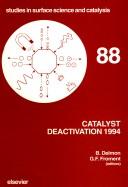
ISBN: 0444816828 9786611793388 1281793388 0080887384 9780444816825 9780080887388 Year: 1994 Volume: 88 98 Publisher: Amsterdam ; New York : Elsevier,
Abstract | Keywords | Export | Availability | Bookmark
 Loading...
Loading...Choose an application
- Reference Manager
- EndNote
- RefWorks (Direct export to RefWorks)
Catalyst Deactivation 1994 was an expansion of earlier, highly successful symposia. The objective of the symposium was to promote a scientific approach of the phenomenon of catalyst deactivation which will contribute to the development of catalysts which are less subject to structural transformations and more resistant to poisons and coke formation. These aspects are dealt with in 12 plenary lectures, 48 oral presentations and 35 poster papers, which were critically selected from an impressive response from some 30 countries. Both fundamental and applied aspects were covered. The deactivatio
Catalyst poisoning --- Catalysis --- Catalyst deactivation --- Catalysts --- Catalytic poisoning --- Poisoning of catalysts --- Deactivation
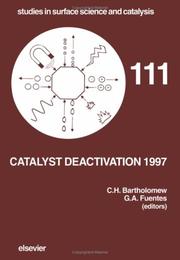
ISBN: 9780444826039 0444826033 9780080528663 008052866X 1281034274 9781281034274 9786611034276 6611034277 Year: 1997 Publisher: Amsterdam [The Netherlands] ; New York : Elsevier,
Abstract | Keywords | Export | Availability | Bookmark
 Loading...
Loading...Choose an application
- Reference Manager
- EndNote
- RefWorks (Direct export to RefWorks)
Catalyst Deactivation 1997 focused on 9 key topical areas: carbon deposition and coke formation, chemicals, environmental catalysis, modeling, petroleum processing, poisoning, syngas conversion, techniques, and thermal degradation. All of these areas were well represented at the meeting; moreover, several review articles were presented that provide perspectives on new research and development thrusts. The proceedings of the meeting are organized with six review and award articles at the front of the volume followed by topical articles a keynote, 5-6 oral, and 2-3 poster papers. A li
Catalyst poisoning --- Catalysts. --- Catalytic agents --- Catalysis --- Chemical inhibitors --- Catalyst deactivation --- Catalysts --- Catalytic poisoning --- Poisoning of catalysts --- Deactivation

ISBN: 0824771737 9780824771737 Year: 1984 Volume: 17 Publisher: New York (N.Y.): Dekker,
Abstract | Keywords | Export | Availability | Bookmark
 Loading...
Loading...Choose an application
- Reference Manager
- EndNote
- RefWorks (Direct export to RefWorks)
Catalyst poisoning --- Catalyst deactivation --- Catalysts --- Catalytic poisoning --- Poisoning of catalysts --- Deactivation --- CATALYSTS --- Monograph --- Catalysts. --- Catalytic agents --- Catalysis --- Chemical inhibitors --- Catalyst poisoning. --- Catalyseurs --- Empoisonnement.
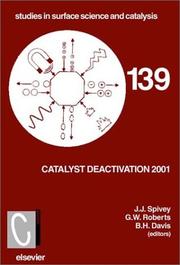
ISBN: 9780444504777 044450477X 9780080528687 0080528686 9786611047221 1281047228 Year: 2001 Publisher: London : Elsevier,
Abstract | Keywords | Export | Availability | Bookmark
 Loading...
Loading...Choose an application
- Reference Manager
- EndNote
- RefWorks (Direct export to RefWorks)
This proceedings contains the papers presented at the 9th International Symposium on Catalyst Deactivation, held in Lexington, KY, USA, on 7-10 October 2001.
Catalyst poisoning --- Chemistry, Technical. --- Chemical technology --- Industrial chemistry --- Technical chemistry --- Chemistry --- Technology --- Chemical engineering --- Catalyst deactivation --- Catalysts --- Catalytic poisoning --- Poisoning of catalysts --- Deactivation
Book
Year: 2022 Publisher: Basel MDPI - Multidisciplinary Digital Publishing Institute
Abstract | Keywords | Export | Availability | Bookmark
 Loading...
Loading...Choose an application
- Reference Manager
- EndNote
- RefWorks (Direct export to RefWorks)
This reprint of “Metal Nanoparticles as Catalysts for Green Applications” collects recent works of researchers on metal nanoparticles as catalysts for green applications. All works deal with designing chemical products and processes that generate and use less (or preferably no) hazardous substances by applying the principles of green chemistry. Despite the interdisciplinary nature of the different applications involved, ranging from pure chemistry to material science, from chemical engineering to physical chemistry, in this reprint there are common characteristics connecting the areas together, and they can be described by two words: sustainability and catalysis.
Technology: general issues --- acetylene hydrogenation --- kinetic model --- catalyst decay --- process modeling --- Al2O3 --- bimetallic catalyst --- syngas --- methane --- partial oxidation --- ZrO2 --- metal–organic framework --- bimetallic metal–organic frameworks --- decarboxylative amidation --- polymeric catalytic membranes --- electrospinning --- HMF oxidation --- glucose --- biochemicals --- MCM-41 --- bimetallic --- reactivity --- product selectivity --- neem --- mint --- nZVI synthesis --- lead --- nickel --- soil remediation --- ethanol steam reforming --- Ni/CeO2 --- microemulsion --- coke resistance --- lanthanum doping --- hydrodeoxygenation --- guaiacol --- regeneration --- catalyst deactivation --- n/a --- metal-organic framework --- bimetallic metal-organic frameworks
Book
Year: 2022 Publisher: Basel MDPI - Multidisciplinary Digital Publishing Institute
Abstract | Keywords | Export | Availability | Bookmark
 Loading...
Loading...Choose an application
- Reference Manager
- EndNote
- RefWorks (Direct export to RefWorks)
This reprint of “Metal Nanoparticles as Catalysts for Green Applications” collects recent works of researchers on metal nanoparticles as catalysts for green applications. All works deal with designing chemical products and processes that generate and use less (or preferably no) hazardous substances by applying the principles of green chemistry. Despite the interdisciplinary nature of the different applications involved, ranging from pure chemistry to material science, from chemical engineering to physical chemistry, in this reprint there are common characteristics connecting the areas together, and they can be described by two words: sustainability and catalysis.
acetylene hydrogenation --- kinetic model --- catalyst decay --- process modeling --- Al2O3 --- bimetallic catalyst --- syngas --- methane --- partial oxidation --- ZrO2 --- metal–organic framework --- bimetallic metal–organic frameworks --- decarboxylative amidation --- polymeric catalytic membranes --- electrospinning --- HMF oxidation --- glucose --- biochemicals --- MCM-41 --- bimetallic --- reactivity --- product selectivity --- neem --- mint --- nZVI synthesis --- lead --- nickel --- soil remediation --- ethanol steam reforming --- Ni/CeO2 --- microemulsion --- coke resistance --- lanthanum doping --- hydrodeoxygenation --- guaiacol --- regeneration --- catalyst deactivation --- n/a --- metal-organic framework --- bimetallic metal-organic frameworks
Book
Year: 2022 Publisher: Basel MDPI - Multidisciplinary Digital Publishing Institute
Abstract | Keywords | Export | Availability | Bookmark
 Loading...
Loading...Choose an application
- Reference Manager
- EndNote
- RefWorks (Direct export to RefWorks)
This reprint of “Metal Nanoparticles as Catalysts for Green Applications” collects recent works of researchers on metal nanoparticles as catalysts for green applications. All works deal with designing chemical products and processes that generate and use less (or preferably no) hazardous substances by applying the principles of green chemistry. Despite the interdisciplinary nature of the different applications involved, ranging from pure chemistry to material science, from chemical engineering to physical chemistry, in this reprint there are common characteristics connecting the areas together, and they can be described by two words: sustainability and catalysis.
Technology: general issues --- acetylene hydrogenation --- kinetic model --- catalyst decay --- process modeling --- Al2O3 --- bimetallic catalyst --- syngas --- methane --- partial oxidation --- ZrO2 --- metal-organic framework --- bimetallic metal-organic frameworks --- decarboxylative amidation --- polymeric catalytic membranes --- electrospinning --- HMF oxidation --- glucose --- biochemicals --- MCM-41 --- bimetallic --- reactivity --- product selectivity --- neem --- mint --- nZVI synthesis --- lead --- nickel --- soil remediation --- ethanol steam reforming --- Ni/CeO2 --- microemulsion --- coke resistance --- lanthanum doping --- hydrodeoxygenation --- guaiacol --- regeneration --- catalyst deactivation
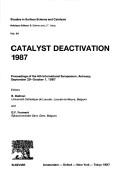
ISBN: 0444428550 9780444428554 9780080960685 0080960685 1282034979 9781282034976 9786612034978 6612034971 0444418016 Year: 1987 Publisher: Amsterdam : Elsevier Science Pub. Co.,
Abstract | Keywords | Export | Availability | Bookmark
 Loading...
Loading...Choose an application
- Reference Manager
- EndNote
- RefWorks (Direct export to RefWorks)
This Symposium on Catalyst Deactivation ensues those held at Berkeley (1985), Antwerp (1980) and Berkeley (1978).The three main topics emphasised at this most recent symposium were: the techniques used in deactivation studies, the mechanisms of catalyst deactivation, and modelling. With respect to the first, it became apparent that the study of deactivation faces even more difficulties than the characterization of fresh catalysts and the measurement of activity or selectivity, due to the multiplicity of interacting processes occurring during deactivation.
Chemical thermodynamics --- fysicochemie --- 541.128 --- 66.097.7 --- 66.097.8 --- #KVIV --- 66.097.8 Negative catalysis. Inhibition. Inhibitors. Retarders. Reaction stabilizers --- Negative catalysis. Inhibition. Inhibitors. Retarders. Reaction stabilizers --- 66.097.7 Substances for inhibiting or arresting catalysis. Catalyst paralysers --- Substances for inhibiting or arresting catalysis. Catalyst paralysers --- 541.128 Catalysis. Acceleration and retardation of reactions by catalysts. Autocatalysis. Spontaneous combustion --- Catalysis. Acceleration and retardation of reactions by catalysts. Autocatalysis. Spontaneous combustion --- Catalyst poisoning --- Congresses --- Catalyst deactivation --- Catalysts --- Catalytic poisoning --- Poisoning of catalysts --- Deactivation --- Anorganische chemie
| Listing 1 - 10 of 19 | << page >> |
Sort by
|

 Search
Search Feedback
Feedback About UniCat
About UniCat  Help
Help News
News